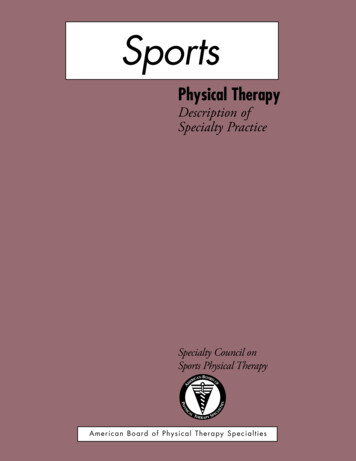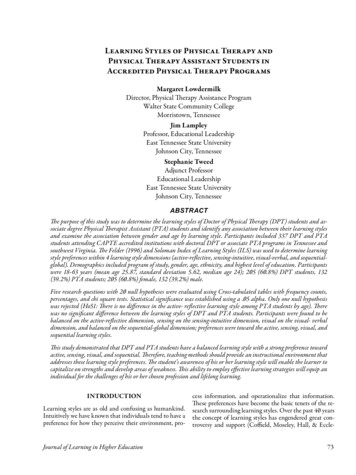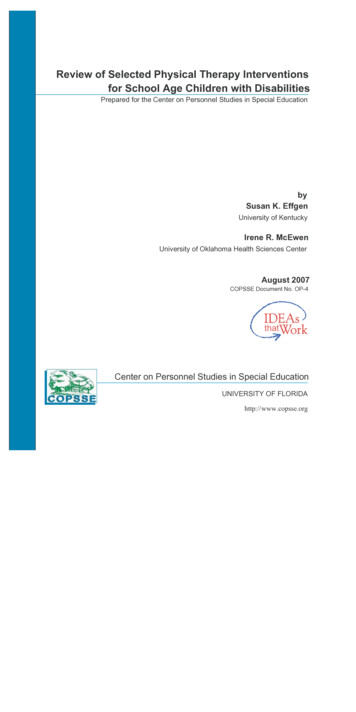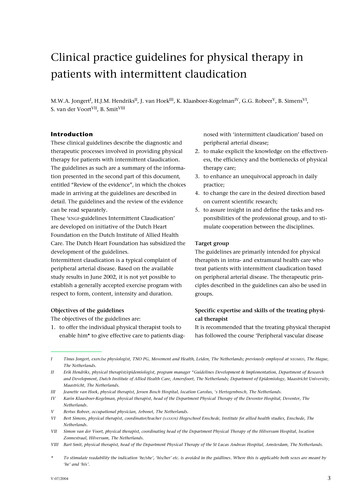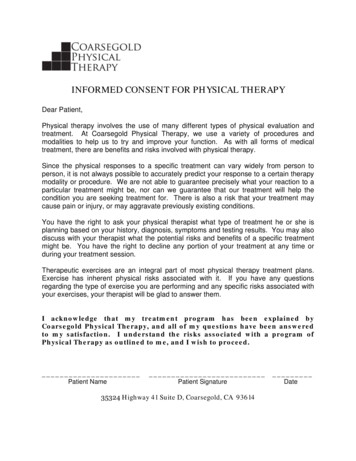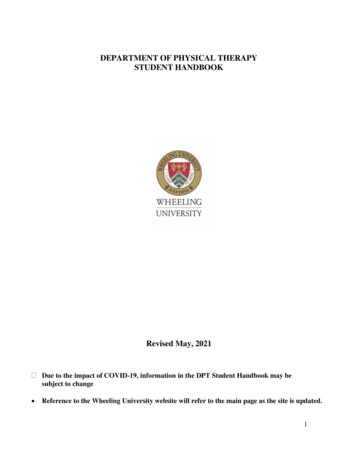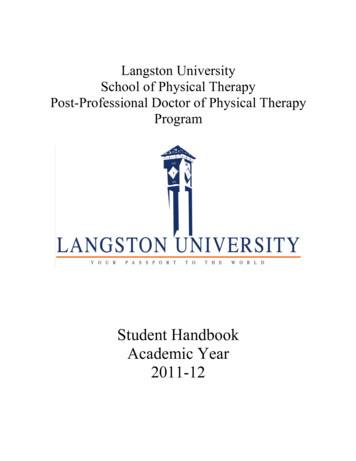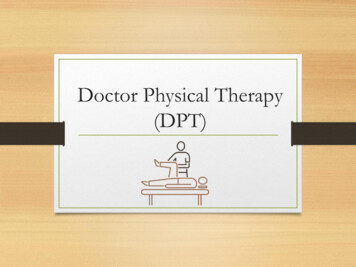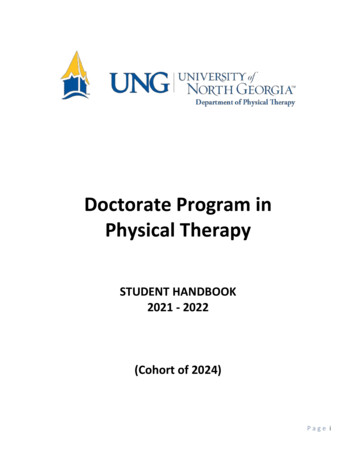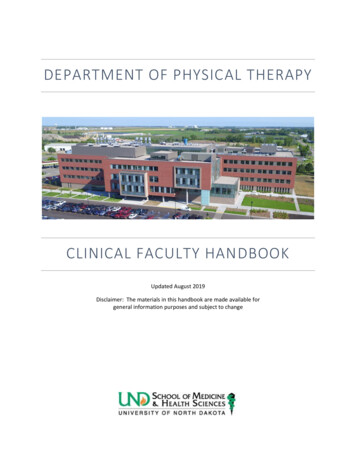
Transcription
DEPARTMENT OF PHYSICAL THERAPYCLINICAL FACULTY HANDBOOKUpdated August 2019Disclaimer: The materials in this handbook are made available forgeneral information purposes and subject to change
Blank Page
ContentsINTRODUCTION . 1WELCOME . 1DEPARTMENT/CAMPUS CONTACTS . 2PHILOSOPHY STATEMENT . 7MISSION STATEMENT . 7GOALS & OBJECTIVES. 8CORE VALUES . 10STUDENT CLINICAL EXPERIENCES . 11GUIDELINES & STUDENT RIGHTS & RESPONSIBILITIES . 11CLINICAL EXPERIENCES - 2nd YEAR . 11CLINICAL EXPERIENCES - 3rd YEAR . 12CLINICAL SITE SELECTION. 12ASSIGNMENTS . 12EVALUATIONS . 13FIRST WEEK OF CLINICAL EXPERIENCE. 13ABSENCES . 13INTRODUCTION TO PATIENT OR CLIENT. 14DRESS AND APPEARANCE . 14HOLIDAYS . 15HEALTH INFORMATION . 15STUDENT PROFESSIONAL LIABILITY INSURANCE . 16CPR CERTIFICATION . 16CRIMINAL BACKGROUND CHECK . 16CORE VALUES . 16CANCELLATION OR CHANGE POLICY . 16STANDARD PRECAUTIONS . 17COMPLAINTS. 17FINANCIAL . 17STUDENT INFORMATION FORM . 17ADDITIONAL IDEAS AND SUGGESTIONS . 17QUESTIONS AND CONCERNS CONTACT. 18SCCE & CI INFORMATION. 19SITE COORDINATOR OF CLINICAL EDUCATION DUTIES AND RESPONSIBILITES. 19CLINICAL INSTRUCTOR DUTIES AND RESPONSIBILITIES. 19PATIENTS/CLIENTS RIGHT OF REFUSAL . 20COMPLAINTS. 20CANCELLATION OR CHANGE POLICY . 20PROGRAM REQUIREMENTS . 21PRE-PHYSICAL THERAPY. 21PROFESSIONAL DPT CURRICULUM . 23COURSE DESCRIPTIONS. 26STUDENT CLINICAL COMPETENCIES . 31PT 510: INTEGRATED CLINICAL EXPERIENCE. 35PT 528: CLINICAL EXPERIENCE I / PT 529: CLINICAL EXPERIENCE II . 37
PT 552: CLINICAL EXPERIENCE III / PT 553: CLINICAL EXPERIENCE IV . 40CLINICAL EXPERIENCE FORMS/DOCUMENTS . 43WEEKLY PLANNING FORM . 44CLINICAL PERFORMANCE INSTRUMENT. 44
INTRODUCTIONWELCOMEThank you for being a part of the University of North Dakota Department of Physical Therapy as a clinicalexperience site. As Director of Clinical Education, I would like to thank you for your past support andanticipated future involvement in our program. I am hopeful this clinical faculty handbook will provide youand the clinical instructors an overview of our program and critical documents that students are provided asa guide for their clinical experiences. We hope this will assist you as clinical faculty in providing a beneficialexperience for the student as well as the staff at your facility.We do continue to offer the benefit of an account for electronic access to journals through the Harley FrenchMedical Library at the University of North Dakota to the clinical coordinator and any clinical instructor whoworks with a student from the University of North Dakota. For the clinical coordinator this is an ongoingbenefit and for clinical instructors it will remain active for 18 months. To obtain access send an email tocindy.flom.meland@UND.edu for clearance and instructions for application.Materials to support clinical education are also available on the APTA website at www.apta.org under Career& Education. Follow the link to “Clinical Educators”. Listed below are some documents that you may finduseful.Clinical Educator Development Reference Material for Site Coordinators of Clinical Education Credentialed Clinical Instructor Program (CCIP) Advanced Credentialed Clinical Instructor Program (ACCIP)Clinical Site Development Guidelines and Self-assessments for Clinical Education Clinical Site Information Form (CSIF) PT Student Site Evaluation FormRegulations Related to Students APTA Policies & Positions Medicare Payment & Reimbursement: Supervision of Students Under Medicare ChartIn addition to me, our Clinical Education team at UND consists Schawnn Decker, Assistant Director of ClinicalEducation (schawnn.decker@UND.edu) and our Administrative Secretary, Bev Voigt,(beverly.voigt@UND.edu).Thank you again for your interest in the University of North Dakota Department of Physical Therapy. I lookforward to working with you. If I may be of assistance at any time, please feel free to contact me atcindy.flom.meland@UND.edu or by phone to (701) 777-4130.Sincerely, Cindy Flom-Meland, PT, PhD, NCSProfessor and Director of Clinical EducationCLINICAL FACULTY HANDBOOK (July 2019) UND SMHS DEPARTMENT OF PHYSICAL THERAPYPage 1
DEPARTMENT/CAMPUS CONTACTSUniversity of North Dakota, Department of Physical Therapy, School of Medicine & Health Sciences E3211301 North Columbia Road Stop 9037, Grand Forks, ND 58202-9037Office Hours: 8:00 a.m. to 4:30 p.m. Main Office: 701-777-2831Department Faculty/Staff:Dave RellingCindy Flom-MelandThomas MohrSue JenoMark RomanickMeridee DanksGary SchindlerMichelle LaBrecqueSchawnn DeckerSteven HalcrowMohamed ElhamadanyEmily HennemanAlyson WhiteAnna PendletonBev VoigtCampus Resources:Affirmative Action OfficeCareer ServicesChester Fritz LibraryDivision of Student AffairsDisability Services for StudentsHealth Sciences LibraryMemorial Union Info CenterSchool of Graduate StudiesOne-Stop Student ServicesStudent Financial AidStudent Health ServicesUniversity BookstoreUniversity Counseling CenterUniversity PoliceUniversity Tech Support (IT)Writing CenterProfessor/Department ChairProfessor/Director of Clinical EducationProfessor/Associate Dean for Health SciencesAssociate ProfessorProfessorAssistant ProfessorAssociate Professor/Director of Sports PT ResidencyPart-time Assistant ProfessorPart-time Assistant Professor, Assistant DCEAssistant ProfessorAssistant ProfessorAssistant ProfessorAdministrative OfficerAdministrative SecretaryAdministrative Secretary, Clinical Twamley Hall, 264 Centennial Dr.Twamley Hall, 264 Centennial Dr.3051 University AveMcCannel Hall, 2891 2nd Ave NMcCannel Hall, 2891 2nd Ave NSMHS Bldg. 1301 N Columbia RdHousing Office, 525 Stanford RdTwamley Hall, 264 Centennial Dr.Twamley Hall, 264 Centennial Dr.Twamley Hall, 264 Centennial Dr.McCannel Hall, 2891 2nd Ave N755 Hamline StMcCannel Hall, 2891 2nd Ave N3851 Campus RdChester Fritz Library, Lower Level, 3051 University AveMerrifield Hall, 276 Centennial 77-2127777-3491777-6305777-2795102103/106CLINICAL FACULTY HANDBOOK (July 2019) UND SMHS DEPARTMENT OF PHYSICAL THERAPYPage 2300271/290E20210520420410020012
DEPARTMENT FACULTY & STAFFDavid Relling, PT, PhDProfessor Physical Therapy and Chair. BSPT, University of North Dakota; M.S.,Kinesiology, Kansas State University; PhD, Physiology, University of North Dakota.Dr. Relling became Chair of the Department of Physical Therapy in June 2014. He hasserved on numerous University committees and is active on the North Dakota Board ofPhysical Therapy and Federation of State Boards of Physical Therapy. Dr. Relling teachesa number of courses in the areas of pathology, acute care, and cardiopulmonary PT. Areasof research interests include exercise physiology, orthopedics, EMG and motion analysis.Cindy Flom-Meland, PT, PhD, NCSProfessor of Physical Therapy and Director of Clinical Education. BSPT, MPT, PhD, Teaching& Learning, University of North Dakota and Graduate, Education Leadership InstituteFellowship, American Physical Therapy Association (2019). Dr. Flom-Meland is theDirector of Clinical Education and primarily works with students and clinicians to arrangeclinical experiences and obtain clinical sites for students. Dr. Flom-Meland is acredentialed trainer for the APTA Clinical Instructor Education and Credentialing Program;active in the North Dakota Physical Therapy Association, APTA, and Universitycommittees; and currently President of the North Dakota Physical Therapy Association.Dr. Flom-Meland teaches in the areas of communication and professional behavior,motor control, psychological aspects, and neuro-rehabilitation. Areas of researchinterests include neuro-rehabilitation, clinical education, and professional behavior.Thomas Mohr, PT, PhD, FAPTAChester Fritz Distinguished Professor and Associate Dean for Health Sciences. BSPT,University of North Dakota; M.S., Physical Therapy, University of Minnesota: PhD,Physiology, University of North Dakota. Dr. Mohr served as Chair of the Department ofPhysical Therapy from 1993 to 2014. He teaches in the areas of neuroscience, research,electrotherapy, and biomechanics. Areas of research are PT Education, PT regulation,Biomechanics, Electromyography, and Motion Analysis.Susan Jeno, PT, PhDAssociate Professor of Physical Therapy. BSPT University of Michigan-Flint: B.S. and M.A.,Education/Kinesiology, University of Michigan; PhD, Anatomy and Cell Biology, Universityof North Dakota. Dr. Jeno serves as the University NCAA Faculty Athletics Representativeand participates in numerous campus and professional committees. She chaired theUniversity Senate, active in University governance, and maintains an active role in the PTprofession. Dr. Jeno teaches anatomy, biomechanics, orthopedics, manual therapy, acutecare, and administration. Areas of research interest are primarily in anatomy, oncology,biomechanics, electromyography, orthopedics exercise science, andalternative/complimentary medicine.CLINICAL FACULTY HANDBOOK (July 2019) UND SMHS DEPARTMENT OF PHYSICAL THERAPYPage 3
Mark Romanick, PT, PhD, ATCProfessor of Physical Therapy. BSPT and MPT, University of North Dakota. PhD,Physiology, University of North Dakota; Athletic Training, University of Idaho. Dr.Romanick served as an officer and is a Hall of Fame member in the North Dakota AthleticTrainers Association. He served on the Board of Directors in the Mid-America AthleticTrainers’ Association and is current treasurer of the North Dakota Physical TherapyAssociation. Dr. Romanick teaches in the areas of biomechanics and kinesiology, clinicalexamination and evaluation, manual therapy, intervention techniques, prevention andwellness, advanced anatomy, and sports physical therapy. Areas of interest are sportsmedicine, orthopedics, biomechanics, and biology of aging.Meridee Danks, PT, DPT, NCSAssistant Professor of Physical Therapy. BSPT, MPT, and DPT; University of North Dakota.Dr. Danks has an extensive clinical background working with patients following spinal cordinjuries, stroke, traumatic brain injuries and other neurological diseases. Dr. Danks iscurrently serving on the University’s Institutional Review Board and is active in the NorthDakota Physical Therapy Association. Dr. Danks teaches in the areas of motor control,applied movement science and rehabilitation, biomechanics and kinesiology, clinicalexamination and case management. Areas of research include balance training, gaitanalysis and pressure mapping.Gary Schindler, PT, DPT, PhD, OCS, SCS, ATC, CSCSAssociate Professor of Physical Therapy and Director of Sports Physical Therapy Residency.BA in Athletic Training, University of North Dakota; MSPT University of Wisconsin-LaCrosse; DPT Massachusetts General Hospital Institute of Health Professionals; and PhD,Educational Leadership at UND. Recognized by ABPTS as an Orthopaedic CertifiedSpecialist in 2008 and Sports Certified Specialist in 2015. Clinical instructor for ten years.Assisted with the UW-Madison and Meriter Hospital orthopaedic residency program. Dr.Schindler practices as a physical therapist and certified athletic trainer, PRN, in anorthopaedic private practice. Teaching areas of orthopaedics, sports medicine, anatomyand therapeutic agents. Research interest areas include leadership development, sportsmedicine, orthopaedics, and anatomy.Michelle LaBrecque, PT, DPTAssistant Professor of Physical Therapy. BSPT, University of Minnesota;MPT and DPT, University of North Dakota. Dr. LaBrecque works part-time in theDepartment of Physical Therapy and part-time in a physical therapy clinic outside theuniversity. Areas of teaching are motor control, clinical examination and evaluation,therapeutic agents, intervention techniques, and applied movement science andrehabilitation.CLINICAL FACULTY HANDBOOK (July 2019) UND SMHS DEPARTMENT OF PHYSICAL THERAPYPage 4
Schawnn Decker, PT, DPTAssistant Professor of Physical Therapy. BSPT, MPT and DPT, University of NorthDakota. Dr. Decker works 3/4 time for the Department of Physical Therapy. She isinvolved in a number of courses with primary focus on orthopedics. Areas of teachinginclude musculoskeletal and clinical examination and evaluation, manual therapy,prevention and wellness, electrotherapy and modalities. Dr. Decker is also anAssistant Director of Clinical Education.Steven Halcrow, PT, DPT, OCSAssistant Professor of Physical Therapy. PT, DPT University of North Dakota. Dr. Halcrowteaches in the areas of biomechanics and kinesiology, clinical examination and evaluationand exercise interventions. Dr. Halcrow is Astym Therapy certified, Orthopedic CertifiedSpecialist, and an APTA Credentialed Clinical Instructor. His areas of interest areorthopedics, sports medicine, manual therapy, biomechanics and kinesiology.Mohamed Elhamadany, BSPT, MS, PhD, PCSAssistant Professor of Physical Therapy, BSPT, MS, and PhD in Physical Therapy forPediatrics Surgery, Cairo University; DPT Dominican College of Blauvelt; Recognized byABPTS as a Pediatric Certified Specialist (PCS). Over the past 20 years, Dr. Elhamadany hasbeen evaluating and treating children and adults with developmental disabilities in avariety of clinical settings. As an APTA credentialed instructor, he provided excellentclinical experience for students from a variety of DPT programs. He has served as anexpert in numerous professional and organization committees, including safe patienthandling committee. Dr. Elhamadany teaches in the area of evidence based practice,pediatrics, research, statistics, and geriatrics. Areas of research interest are primarily indisease and functioning taxonomies, pediatrics, EMG, motion analysis, therapeuticmodalities, and virtual reality.Emily Henneman, PT, DPTAssistant Professor of Physical Therapy. PT, DPT University of Minnesota. Dr. Hennemanteaches in the areas of cardio-pulmonary care, physical therapy across the lifespan,administration and case management. Her clinical background includes working with thegeriatric population in the home health and hospice setting. Dr. Henneman is activelyinvolved in the Home Health Section of the APTA. Areas of interest include pediatrics,geriatrics, home health, telehealth and hospice.CLINICAL FACULTY HANDBOOK (July 2019) UND SMHS DEPARTMENT OF PHYSICAL THERAPYPage 5
Alyson C. White, BSBAAdministrative Officer and Coordinator of Admissions. Alyson has been with theDepartment of Physical Therapy since 1975. She holds a Bachelor of Science in BusinessAdministration from University of North Dakota. Alyson serves the North Dakota PhysicalTherapy Association as Executive Officer. Alyson works with budgets, WICHE, admissionsand a variety of other duties. She assists with the advisement of both pre-professionaland professional students regarding, registration, financial aid, graduation requirements,and housing.Anna PendletonAdministrative Secretary. Anna graduated from the University of California Riverside in2013 with a Bachelor of Arts Degree in History. She also earned a Certificate in TeachingEnglish to Speakers of Other Languages (TESOL) in 2014 and a Certificate in CollegeAdmissions Counseling in 2018, both from the University of California RiversideExtension. Anna recently relocated to North Dakota from Southern California where sheworked in international student programs for four years. Anna enjoys cooking, camping,and traveling, having explored the British Isles, Canada, and the western half of theUnited States.Bev VoigtAdministrative Secretary, Clinical Education. Bev joined the Department of PhysicalTherapy in July of 2017. Bev provides administrative and technical support for thedepartment with primary focus on the clinical education program. She is responsible forfront office tasks while troubleshooting and managing multiple databases; coordinatingcommunications between students, academic/clinical faculty and staff, and maintains thedepartmental website.CLINICAL FACULTY HANDBOOK (July 2019) UND SMHS DEPARTMENT OF PHYSICAL THERAPYPage 6
PHILOSOPHY STATEMENTThe UND Physical Therapy program seeks to graduate physical therapists concerned with providing qualityphysical therapy services within a variety of practice environments. The graduate is to be an advocate forhealth and wellness at the individual and societal levels. The graduate is expected to develop the skillsnecessary for incorporating evidence into their clinical practice and demonstrate a commitment to life-longlearning.The Department believes physical therapy education is best accomplished through the interplay ofcurriculum, faculty and students. The curriculum, inclusive of liberal arts, foundational sciences, clinicalsciences and complimentary clinical education, is presented through a hybrid model. The hybrid curriculummodel incorporates a variety of teaching methodologies including lecture, problem solving, team based, casescenario, and clinical experiences. A progression in concept development from simple to complex is evident.The curriculum promotes skills for life-long learning, encourages the critical analysis of current and newknowledge, supports critical inquiry/research for the advancement of the profession, and advocates serviceto the community and the profession.The role of faculty is to facilitate the teaching and learning process, and to enable and challenge the growthof the learner. The faculty, with diverse interests and experiences, are expected to model professionalbehaviors of education, scholarly activity, service, and life-long learning.Students are expected to be self-aware, self-directed, and responsible for their learning. They are presumedto be intellectually curious and possess a desire to be reflective learners and practitioners. Students willdemonstrate respect for self and others, and a commitment to the profession of physical therapy.It is also the intent that the professional program be reviewed periodically and evaluated by academic andclinical faculty, students, practitioners and other community and university personnel to maintain an optimaleducational experience for students. It is expected that the program will continually evolve in response topolitical, social, economic and professional forces and emerging health care delivery trends.MISSION STATEMENT“The mission of the Department of Physical Therapy is to prepare physical therapists with the clinical,professional and critical inquiry skills to provide quality physical therapy services. The professional servicesprovided by a physical therapist demand a strong background in the liberal arts and clinical sciences as well ashigh moral and ethical standards. In addition to clinical practice expectations, responsibilities in teaching,service and critical inquiry are an integral part of the educational experience.”CLINICAL FACULTY HANDBOOK (July 2019) UND SMHS DEPARTMENT OF PHYSICAL THERAPYPage 7
GOALS & OBJECTIVESSTUDENTS:Goal 1: The student will demonstrate the skills necessary for the entry level practice of physical therapy. Objective: The student will demonstrate entry-level competence on all written and practicalexaminations. Objective: The students will demonstrate entry-level competence in all clinical skills by the end oftheir clinical experiences. Objective: The student will demonstrate entry-level skill in physical therapy examination,evaluation, diagnosis, and the development of an appropriate plan of care and physicaltherapy intervention.Objective: The student will plan, initiate, coordinate and evaluate the efficacy of interventionprograms to meet patient/client needs.Objective: The student will demonstrate effective written and oral communication skills.Objective: The student will demonstrate knowledge of basic administrative procedures.Objective: The student will demonstrate professionalism in the classroom and in the clinic.Goal 2: The student will demonstrate advocacy skills for health and wellness at the individual and societallevel. Objective: The student will develop an awareness of the importance of physical therapy incommunity health systems and participate in service learning projects and activities. Objective: The student will demonstrate proper concern for patient’s rights. Objective: The student will participate in an advocacy role regarding health, wellness, and societalneeds.Goal 3: The student will provide service to the community and/or to the profession. Objective: The student will participate in service learning projects and activities. Objective: The student will participate in professional service activities.Goal 4: The student will develop critical inquiry skills related to clinical and basic science research. Objective: The student will demonstrate a commitment to evidence based practice, interpretingand applying the results of published research Objective: The student will apply principles of the scientific method and collaborate with facultyand peers to design and implement a scholarly project.Goal 5: The student will develop the skills required for life-long learning. Objective: The student will demonstrate a commitment to evidence based practice, continuingeducation and involvement in professional organizations. Objective: The student is expected to be self-aware, self-directed, and responsible for his or herlearning.CLINICAL FACULTY HANDBOOK (July 2019) UND SMHS DEPARTMENT OF PHYSICAL THERAPYPage 8
FACULTY:Goal 1: Faculty members will demonstrate excellence in teaching. Objective: Faculty members will apply learning theories in designing, implementing and evaluatinglearning experiences. Objective: Faculty will implement teaching strategies appropriate for the content domain andlearner characteristics.Objective: Faculty members will respond to changes in the health care and educationalenvironments in a timely and thoughtful manner for continuous improvement ofcurriculum and practice.Objective: Faculty members will promote and model academic excellence, reflective practice, andlife-long learning.Goal 2: Faculty members will provide service and leadership to the physical therapy profession. Objective: Faculty members will demonstrate an active role in community and/or professionalservice involvement and encourage that same activity in the professional students.Goal 3: Faculty members will enhance the clinical and scientific knowledge base of physical therapythrough creative and scholarly activities. Objective: Faculty members are expected to engage in research activities that will contribute to thebody of knowledge in physical therapy. Objective: Faculty members should provide evidence for the methods, procedures and theoriestaught in the curriculum. Objective: Faculty members must show accomplishments in teaching, service and scholarly activitythat are consistent with the expectations for promotion.DEPARTMENT:GOAL 1: The Department will attract and support faculty who align with the mission and vision of theinstitution and the collaborative spirit of the program and curricular philosophies.GOAL 2: The Department will support and develop faculty who are recognized for advancing the physicaltherapy profession through excellence in teaching, clinical practice, scholarly activity and service to theprofession.CLINICAL FACULTY HANDBOOK (July 2019) UND SMHS DEPARTMENT OF PHYSICAL THERAPYPage 9
CORE VALUESAccountability: Active acceptance of the responsibility for the diverse roles, obligations, and actions of thephysical therapist including self-regulation and other behaviors that positively influence patient/clientoutcomes, the profession and the health needs of society.Altruism: Primary regard for or devotion to the interest of patients/clients, thus assuming the fiduciaryresponsibility of placing the needs of the patient/client ahead of the physical therapist’s self-interest.Compassion and Caring: Compassion: The desire to identify with or sense something of another’sexperience; a precursor of caring. Caring: The concern, empathy, and consideration for the needs and valuesof others.Excellence: Physical therapy practice that consistently uses current knowledge and theory w
Credentialed Clinical Instructor Program (CCIP) Advanced Credentialed Clinical Instructor Program (ACCIP) Clinical Site Development Guidelines and Self-assessments for Clinical Education Clinical Site Information Form (CSIF) PT Student Site Evaluation Form Regulations Related to Students APTA Policies & Positions
